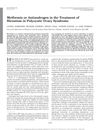The Evaluation of the Role of Androgens in Hirsutism and the Use of a New Anti-Androgen Cyproterone Acetate for Therapy
TLDR Cyproterone acetate combined with ethinyl estradiol significantly reduced hirsutism in women.
In a study from 1974, researchers found that hirsutism in women was associated with elevated testosterone levels, as evidenced by a significant difference in mean plasma testosterone between normal women (14 participants) and hirsute women (26 participants). Short-term adrenal stimulation and suppression tests yielded inconsistent results, but long-term suppression with dexamethasone or an oral contraceptive pill showed a dual contribution of the adrenal glands and ovaries to androgen levels, without significant improvement in hirsutism. However, treatment with the anti-androgen cyproterone acetate (CA), in combination with ethinyl estradiol (EE) to maintain menstrual cycle regularity and prevent pregnancy, led to a marked reduction in hirsutism in 5 patients over 12 months. This treatment decreased the frequency of shaving from 3 times per week to 3 times per month, although hair growth rate increased again after stopping CA. Plasma and urinary testosterone levels were also reduced during therapy.
